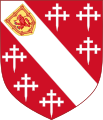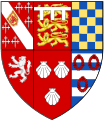Howard family facts for kids
Quick facts for kids Howard family |
|
|---|---|
| Noble family | |
 Coat of arms of Howard, granted to Thomas Howard, 2nd Duke of Norfolk |
|
| Country | Kingdom of England, United Kingdom |
| Founded | 1483 |
| Founder | John Howard, 1st Duke of Norfolk |
| Current head | Edward Fitzalan-Howard, 18th Duke of Norfolk |
| Titles |
See list
Extant titles
|
| Estate(s) | |
| Cadet branches |
|
The Howard family is a very old and important noble family from England. It was started by John Howard in 1483. He was made the first Duke of Norfolk by King Richard III of England.
The Howards have been a big part of the peerage (a system of noble titles) since the 1400s. They are still the most important Dukes and Earls in England. They also hold a special job called Earl Marshal of England.
During the English Reformation, when England changed its main religion, many Howards stayed Catholic. They were one of the most well-known families to do so. Two members, Philip Howard and William Howard, 1st Viscount Stafford, are remembered as important figures for their faith.
The main line of the family holds the title of Duke of Norfolk. They are also the Earl of Arundel, Earl of Surrey, and Earl of Norfolk. They inherited the Arundel title in 1580. This happened when the Howards became the family next in line to the FitzAlans.
Thomas Howard, 4th Duke of Norfolk, married Mary FitzAlan. She became the heir to the Arundel family's lands. Her son was Philip Howard. Because of this marriage, the current Duke of Norfolk uses the name FitzAlan-Howard. Their main home is Arundel Castle.
There are also several other important branches of the Howard family. These include the Howards of Effingham, Howards of Carlisle, Howards of Suffolk, and Howards of Penrith.
The Howards have played a big role throughout English and later British history. They claim to be related to Hereward the Wake, a famous English hero. John Howard, 1st Duke of Norfolk, fought and died for King Richard III at the Battle of Bosworth Field.
The Howards became important again under the new Tudor kings and queens. They helped defend England from a Scottish invasion at the Battle of Flodden. Later, Catherine Howard became the fifth wife of King Henry VIII. Her uncle, Thomas Howard, 3rd Duke of Norfolk, was a very powerful person in Henry VIII's government.
Charles Howard, 1st Earl of Nottingham, was the leader of the English fleet. This fleet famously defeated the invading Spanish Armada.
Arundel Castle has been owned by the Duke of Norfolk's family for over 400 years. It is still their main home. It is a very important historic building in England.
Contents
Family Beginnings

The Howard family has a long history. Some later Howards said they were related to Hereward the Wake. He was a famous English fighter who resisted the Norman conquest of England. Hereward became a well-known hero in English folklore.
A family tree made in 1665 said the Howards came from the Howarth family in Rochdale. It suggested they were related to William Howard of Wigenhall. This William Howard was said to have received land for his service to King Henry I. However, this early history has been debated by historians.
The family's clear history begins with Sir William Howard (died 1308). He was a judge in Norfolk. He was called to be a justice in the House of Commons in 1295. Sir William's son, Sir John Howard I, became the Sheriff of Norfolk and Suffolk. He married Joan de Cornwall, who was a granddaughter of Richard, 1st Earl of Cornwall.
Important Moments in History

Sir William's great-great-great-grandson, Sir Robert Howard, married Lady Margaret Mowbray. She was the daughter of Thomas Mowbray, 1st Duke of Norfolk. The Mowbray line of Dukes ended in 1476. The last Mowbray Duke's heir, Anne Mowbray, died young.
After this, King Richard III of England made John Howard, 1st Duke of Norfolk, a new Duke in 1483. John was also made the hereditary Earl Marshal. John's son, Thomas Howard, 2nd Duke of Norfolk, was the grandfather of two English queens: Anne Boleyn and Catherine Howard. Both were wives of Henry VIII.

The Howard family became known for staying Catholic during the English Reformation. This was a time when England changed its official religion. Because of their faith, they often could not take their places in the House of Lords.
Some family members faced difficulties because of their Catholic beliefs. Henry Howard, Earl of Surrey, lost his titles in 1547. His son, Thomas Howard, 4th Duke of Norfolk, also lost his titles in 1572. Norfolk's son, Philip Howard, 13th Earl of Arundel, was put in the Tower of London for his Catholicism in 1585. He stayed there for over ten years until he died in 1595.
The titles of Duke and Earl Marshal were sometimes taken away and then given back to the Howards. Before King Charles II finally gave the titles back for good, the Howards inherited the old title of Earl of Arundel. They also formed new family branches that still exist today.
One branch of the Howard family has lived at Castle Howard for over 300 years. It is one of England's most beautiful country homes.
Here are some of the main branches of the Howard family:
- The Barons Howard of Penrith come from a younger brother of the 12th Duke.
- The Earls of Suffolk and Berkshire come from the 2nd son of the 4th Duke.
- The Earls of Carlisle come from the third son of the 4th Duke.
- The Earls of Effingham come from the fourth son of the 2nd Duke. This ancestor was a Lord High Admiral and led the fleet against the Spanish Armada.
Howard Family Tree
| Earls of Norfolk and Dukes of Norfolk | |||||||||||||||||||||||||||||||||||||||||||||||||||||||||||||||||||||||||||||||||||||||||||||||||||||||||||||||||||||||||||||||||||||||||||||||||||||||||||||||||||||||||||||||||||||||||||||||||||||||||||||||||||||||||||||||||||||||||||||||||||||||||||||||||||||||||||||||||||||||||||||||||||||||||||||||||||||||||||||||||||||||||||||||||||||||||||||||||||||||||||||||||||||||||||||||||||||||||||||||||||||||||||||||||||||||||||||||||||||||||||||||||||||||||||||||||||||||||||||||||||||||||||||||||||||||||||||||||||||||||||||||||||||||||||||||||||||||||||||||||||||||||||||||||||||||||||||||||||||||||||||||||||||||||||||||||||||||||||||||||||||||||||||||||||||||||||||||||||||||||||||||||||||||||||||||||||||||||||||||||||||||||||||||||||||||||||||||||||||||||||||||||||||||||||||||||||||||||||||||||||||||||||||||||||||||||||||||||||||||||||||||||||||||||||||||||||||||||||||||||||||||||||||||||||||||||||||||||||||||||||||||||||||||||||||||||||||||||||||||||||||||||||||||||||||||||||||||||||||||
|---|---|---|---|---|---|---|---|---|---|---|---|---|---|---|---|---|---|---|---|---|---|---|---|---|---|---|---|---|---|---|---|---|---|---|---|---|---|---|---|---|---|---|---|---|---|---|---|---|---|---|---|---|---|---|---|---|---|---|---|---|---|---|---|---|---|---|---|---|---|---|---|---|---|---|---|---|---|---|---|---|---|---|---|---|---|---|---|---|---|---|---|---|---|---|---|---|---|---|---|---|---|---|---|---|---|---|---|---|---|---|---|---|---|---|---|---|---|---|---|---|---|---|---|---|---|---|---|---|---|---|---|---|---|---|---|---|---|---|---|---|---|---|---|---|---|---|---|---|---|---|---|---|---|---|---|---|---|---|---|---|---|---|---|---|---|---|---|---|---|---|---|---|---|---|---|---|---|---|---|---|---|---|---|---|---|---|---|---|---|---|---|---|---|---|---|---|---|---|---|---|---|---|---|---|---|---|---|---|---|---|---|---|---|---|---|---|---|---|---|---|---|---|---|---|---|---|---|---|---|---|---|---|---|---|---|---|---|---|---|---|---|---|---|---|---|---|---|---|---|---|---|---|---|---|---|---|---|---|---|---|---|---|---|---|---|---|---|---|---|---|---|---|---|---|---|---|---|---|---|---|---|---|---|---|---|---|---|---|---|---|---|---|---|---|---|---|---|---|---|---|---|---|---|---|---|---|---|---|---|---|---|---|---|---|---|---|---|---|---|---|---|---|---|---|---|---|---|---|---|---|---|---|---|---|---|---|---|---|---|---|---|---|---|---|---|---|---|---|---|---|---|---|---|---|---|---|---|---|---|---|---|---|---|---|---|---|---|---|---|---|---|---|---|---|---|---|---|---|---|---|---|---|---|---|---|---|---|---|---|---|---|---|---|---|---|---|---|---|---|---|---|---|---|---|---|---|---|---|---|---|---|---|---|---|---|---|---|---|---|---|---|---|---|---|---|---|---|---|---|---|---|---|---|---|---|---|---|---|---|---|---|---|---|---|---|---|---|---|---|---|---|---|---|---|---|---|---|---|---|---|---|---|---|---|---|---|---|---|---|---|---|---|---|---|---|---|---|---|---|---|---|---|---|---|---|---|---|---|---|---|---|---|---|---|---|---|---|---|---|---|---|---|---|---|---|---|---|---|---|---|---|---|---|---|---|---|---|---|---|---|---|---|---|---|---|---|---|---|---|---|---|---|---|---|---|---|---|---|---|---|---|---|---|---|---|---|---|---|---|---|---|---|---|---|---|---|---|---|---|---|---|---|---|---|---|---|---|---|---|---|---|---|---|---|---|---|---|---|---|---|---|---|---|---|---|---|---|---|---|---|---|---|---|---|---|---|---|---|---|---|---|---|---|---|---|---|---|---|---|---|---|---|---|---|---|---|---|---|---|---|---|---|---|---|---|---|---|---|---|---|---|---|---|---|---|---|---|---|---|---|---|---|---|---|---|---|---|---|---|---|---|---|---|---|---|---|---|---|---|---|---|---|---|---|---|---|---|---|---|---|---|---|---|---|---|---|---|---|---|---|---|---|---|---|---|---|---|---|---|---|---|---|---|---|---|---|---|---|---|---|---|---|---|---|---|---|---|---|---|---|---|---|---|---|---|---|---|---|---|---|---|---|---|---|---|---|---|---|---|---|---|---|---|---|---|---|---|---|---|---|---|---|---|---|---|---|---|---|---|---|---|---|---|---|---|---|---|---|---|---|---|---|---|---|---|---|---|---|---|---|---|---|---|---|---|---|---|---|---|---|---|---|---|---|---|---|---|---|---|---|---|---|---|---|---|---|---|---|---|---|---|---|---|---|---|---|---|---|---|---|---|---|---|---|---|---|---|---|---|---|---|---|---|---|---|---|---|---|---|---|---|---|---|---|---|---|---|---|---|---|---|---|---|---|---|---|---|---|---|---|---|---|---|---|---|---|---|---|---|---|---|---|---|---|---|---|---|---|---|---|---|---|---|---|---|---|---|---|---|---|---|---|---|---|---|---|---|---|---|---|---|---|---|---|---|---|---|---|---|---|---|---|---|---|---|---|---|---|---|---|---|---|---|---|---|---|---|---|---|---|---|---|---|---|---|---|---|---|---|---|---|---|---|---|---|---|---|---|---|---|---|---|---|---|---|---|---|---|---|---|---|---|---|---|---|---|---|---|---|---|---|---|---|---|---|---|---|---|---|---|---|---|---|---|---|---|---|---|---|---|---|---|---|---|---|---|---|---|---|---|---|---|---|---|---|---|---|---|---|
|
|||||||||||||||||||||||||||||||||||||||||||||||||||||||||||||||||||||||||||||||||||||||||||||||||||||||||||||||||||||||||||||||||||||||||||||||||||||||||||||||||||||||||||||||||||||||||||||||||||||||||||||||||||||||||||||||||||||||||||||||||||||||||||||||||||||||||||||||||||||||||||||||||||||||||||||||||||||||||||||||||||||||||||||||||||||||||||||||||||||||||||||||||||||||||||||||||||||||||||||||||||||||||||||||||||||||||||||||||||||||||||||||||||||||||||||||||||||||||||||||||||||||||||||||||||||||||||||||||||||||||||||||||||||||||||||||||||||||||||||||||||||||||||||||||||||||||||||||||||||||||||||||||||||||||||||||||||||||||||||||||||||||||||||||||||||||||||||||||||||||||||||||||||||||||||||||||||||||||||||||||||||||||||||||||||||||||||||||||||||||||||||||||||||||||||||||||||||||||||||||||||||||||||||||||||||||||||||||||||||||||||||||||||||||||||||||||||||||||||||||||||||||||||||||||||||||||||||||||||||||||||||||||||||||||||||||||||||||||||||||||||||||||||||||||||||||||||||||||||||||
Howard Family Coat of Arms
The Howard family's original coat of arms had a white diagonal stripe on a red background with small crosses. When the first Howard Duke of Norfolk married the heir of the Dukes of Norfolk, he combined his arms with those of Thomas of Brotherton, 1st Earl of Norfolk. Thomas was the son of King Edward I. The Howards also added the Mowbray arms.
Starting with the 2nd Duke of Norfolk, the Howards added the checkered blue and gold design of the Warren Earls of Surrey. They became the heirs to this family. Later, the gold lion on red of the Fitzalan Earls of Arundel was added. This happened when Philip Howard inherited the Earldom of Arundel.
-
A special addition to the arms of Thomas Howard, 2nd Duke of Norfolk. This was given to him for his victory at the Battle of Flodden in 1513. It shows a Scottish lion with an arrow, remembering the Scottish king who died in that battle.
The Earl Marshal Role
The Earl Marshal is a very old and important job in the United Kingdom. It is a title passed down through families. The Earl Marshal is one of the top officers of the state in England.
This role is responsible for organizing big royal events. These include State funerals and the King or Queen's coronation ceremony at Westminster Abbey. The Earl Marshal also helps with matters of heraldry (coats of arms and family histories).
This office is passed down through the Howard family. It is held by the Duke of Norfolk, who is the most senior Duke in the United Kingdom.
 |
|
Howard Family Titles
| Title | Grantee | Created | Extinct | Notes |
|---|---|---|---|---|
| 28 June 1483 | The most important duke title in England. | |||
| The most important earl title in England. It has been connected to the Duke of Norfolk since 1660. | ||||
| Connected to the Duke of Norfolk since 1660. | ||||
| Lord William Howard | 1554 | |||
| Charles Howard, 2nd Baron Howard of Effingham | 1596 | 1681 | ||
| Admiral Lord Thomas Howard | 1597 | This title has been held by many different families. | ||
| 1603 | ||||
| Lord Thomas Howard | 1626 | |||
| Edward Howard | 12 April 1628 | 29 April 1715 | ||
| Lord William Howard | 1640 | |||
| 1640 | 1762 | |||
| Mary Howard, 1st Baroness Stafford | 1688 | |||
| Thomas Howard, 14th/21st Earl of Arundel | 1644 | |||
| Charles Howard | 20 April 1661 | The first Earl was also made Viscount Howard by Oliver Cromwell, but this title ended when the monarchy was restored. | ||
| Henry Howard | 30 January 1706 | 8 February 1722 | Held with the Earl of Suffolk from 1709 to 1722. | |
| Francis Howard, 7th Baron Howard of Effingham | 8 December 1731 | 11 December 1816 | ||
| General Kenneth Alexander Howard, 11th Baron Howard of Effingham | 27 January 1837 | |||
| Lord Edward George Fitzalan Howard | 26 November 1869 | This title has been connected to the Dukedom of Norfolk since 1975. | ||
| Admiral The Honourable Edward Granville George Howard | 1 January 1874 | 8 October 1880 | ||
| Lord Edmund Bernard Talbot née FitzAlan-Howard | 28 April 1921 | 17 May 1962 | ||
| Esmé William Howard | 10 July 1930 | |||
| Major George Anthony Geoffrey Howard, JP | 1 July 1983 | 27 November 1984 | This was a Life Peerage, meaning it was for his lifetime only. | |
| Greville Patrick Charles Howard | 4 June 2004 | This is also a Life Peerage. |








